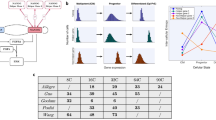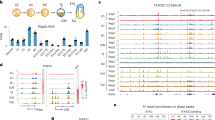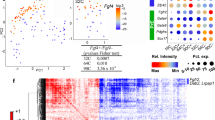Abstract
The first cell fate choice in the mammalian embryo, the segregation of the inner cell mass (ICM) and trophectoderm (TE), is regulated by the mutually antagonistic effects of the transcription factors, Oct4 and Cdx2, while the pluripotency factor, Nanog, is essential to specify the epiblast. We have analyzed the promoters of Nanog and Cdx2, and have found that these two transcription factors are likewise regulated reciprocally. Using an embryonic stem cell line with conditional TE differentiation, we show that Nanog overexpression suppresses the upregulation of TE markers, while Nanog knockdown upregulates the expression of TE markers. We further show that Nanog and Cdx2 bind to and repress each other's promoters. However, whereas Nanog knockout results in detectable Cdx2 expression in the ICM, we observe no overt disruption of blastocyst development, indicating that Nanog plays a subservient role to Oct4 in segregation of the ICM and TE.
Similar content being viewed by others
Log in or create a free account to read this content
Gain free access to this article, as well as selected content from this journal and more on nature.com
or
References
Evans MJ, Kaufman MH . Establishment in culture of pluripotential cells from mouse embryos. Nature 1981; 292:154–156.
Martin GR . Isolation of a pluripotent cell line from early mouse embryos cultured in medium conditioned by teratocarcinoma stem cells. Proc Natl Acad Sci USA 1981; 78:7634–7638.
Tanaka S, Kunath T, Hadjantonakis AK, Nagy A, Rossant J . Promotion of trophoblast stem cell proliferation by FGF4. Science 1998; 282:2072–2075.
Nagy A, Gocza E, Diaz EM, et al. Embryonic stem cells alone are able to support fetal development in the mouse. Development 1990; 110:815–821.
Chambers I, Colby D, Robertson M, et al. Functional expression cloning of Nanog, a pluripotency sustaining factor in embryonic stem cells. Cell 2003; 113:643–655.
Nichols J, Zevnik B, Anastassiadis K, et al. Formation of pluripotent stem cells in the mammalian embryo depends on the POU transcription factor Oct4. Cell 1998; 95:379–391.
Mitsui K, Tokuzawa Y, Itoh H, et al. The homeoprotein Nanog is required for maintenance of pluripotency in mouse epiblast and ES cells. Cell 2003; 113:631–642.
Strumpf D, Mao CA, Yamanaka Y, et al. Cdx2 is required for correct cell fate specification and differentiation of trophectoderm in the mouse blastocyst. Development 2005; 132:2093–2102.
Niwa H, Miyazaki J, Smith AG . Quantitative expression of Oct-3/4 defines differentiation, dedifferentiation or self-renewal of ES cells. Nat Genet 2000; 24:372–376.
Niwa H, Toyooka Y, Shimosato D, et al. Interaction between Oct3/4 and Cdx2 determines trophectoderm differentiation. Cell 2005; 123:917–929.
Ralston A, Rossant J. Genetic regulation of stem cell origins in the mouse embryo. Clin Genet 2005; 68:106–112.
Lu CW, Yabuuchi A, Chen L, Viswanathan S, Kim K, Daley GQ . Ras-MAPK signaling promotes trophectoderm formation from embryonic stem cells and mouse embryos. Nat Genet 2008; 40:921–926.
Hough SR, Clements I, Welch PJ, Wiederholt KA . Differentiation of mouse embryonic stem cells after RNA interference-mediated silencing of OCT4 and Nanog. Stem Cells 2006; 24:1467–1475.
Hyslop L, Stojkovic M, Armstrong L, et al. Downregulation of NANOG induces differentiation of human embryonic stem cells to extraembryonic lineages. Stem Cells 2005; 23:1035–1043.
Wang J, Theunissen TW, Orkin SH . Site-directed, virus-free, and inducible RNAi in embryonic stem cells. Proc Natl Acad Sci USA 2007; 104:20850–20855.
Loh YH, Wu Q, Chew JL, et al. The Oct4 and Nanog transcription network regulates pluripotency in mouse embryonic stem cells. Nat Genet 2006; 38:431–440.
Boyer LA, Lee TI, Cole MF, et al. Core transcriptional regulatory circuitry in human embryonic stem cells. Cell 2005; 122:947–956.
Pan G, Li J, Zhou Y, Zheng H, Pei D . A negative feedback loop of transcription factors that controls stem cell pluripotency and self-renewal. FASEB J 2006; 20:1730–1732.
Ivanova N, Dobrin R, Lu R, et al. Dissecting self-renewal in stem cells with RNA interference. Nature 2006; 442:533–538.
Kyba M, Perlingeiro RC, Daley GQ . HoxB4 confers definitive lymphoid-myeloid engraftment potential on embryonic stem cell and yolk sac hematopoietic progenitors. Cell 2002; 109:29–37.
Ting DT, Kyba M, Daley GQ . Inducible transgene expression in mouse stem cells. Methods Mol Med 2004; 105:23–46.
Cawley S, Bekiranov S, Ng HH, et al. Unbiased mapping of transcription factor binding sites along human chromosomes 21 and 22 points to widespread regulation of noncoding RNAs. Cell 2004; 116:499–509.
Maherali N, Sridharan R, Xie W, et al. Directly reprogrammed fibroblasts show global epigenetic remodeling and widespread tissue contribution. Cell Stem Cell 2007; 1:55–70.
Acknowledgements
GQD was supported by grants from the National Institutes of Health, the NIH Director's Pioneer Award of the NIH Roadmap for Medical Research, and private funds contributed to the Harvard Stem Cell Institute and the Children's Hospital Stem Cell Program, USA. GQD is a recipient of Clinical Scientist Awards in Translational Research from the Burroughs Wellcome Fund and the Leukemia and Lymphoma Society, and is an Investigator at the Howard Hughes Medical Institute. KH was supported by the NIH Director's Innovator Award and the Harvard Stem Cell Institute, USA.
Author information
Authors and Affiliations
Corresponding author
Supplementary information
Supplementary information, Figure S1
Schematic illustration of the inducible system used in this study. (PDF 90 kb)
Supplementary information, Figure S2
Nanog over-expression quantitatively suppresses the up-regulation of TE markers by Ras or Cdx2. (PDF 141 kb)
Supplementary information, Figure S3
Knockdown of Nanog by Stealth RNAi results in up-regulation of Cdx2, as well as Gata6. (PDF 151 kb)
Supplementary information, Figure S4
Mapping Nanog and Oct4 binding sites in the Cdx2 locus. (PDF 129 kb)
Supplementary information, Figure S5
Immunofluorescence of Nanog−/− embryos. (PDF 120 kb)
Supplementary information, Data S1
Primers for cDNA quantification (PDF 35 kb)
Rights and permissions
About this article
Cite this article
Chen, L., Yabuuchi, A., Eminli, S. et al. Cross-regulation of the Nanog and Cdx2 promoters. Cell Res 19, 1052–1061 (2009). https://doi.org/10.1038/cr.2009.79
Received:
Revised:
Accepted:
Published:
Issue date:
DOI: https://doi.org/10.1038/cr.2009.79
Keywords
This article is cited by
-
Tead4 and Tfap2c generate bipotency and a bistable switch in totipotent embryos to promote robust lineage diversification
Nature Structural & Molecular Biology (2024)
-
Sox2 levels regulate the chromatin occupancy of WNT mediators in epiblast progenitors responsible for vertebrate body formation
Nature Cell Biology (2022)
-
Selection of human induced pluripotent stem cells lines optimization of cardiomyocytes differentiation in an integrated suspension microcarrier bioreactor
Stem Cell Research & Therapy (2020)
-
Establishment of bovine embryonic stem cells after knockdown of CDX2
Scientific Reports (2016)
-
Oocyte-expressed yes-associated protein is a key activator of the early zygotic genome in mouse
Cell Research (2016)



